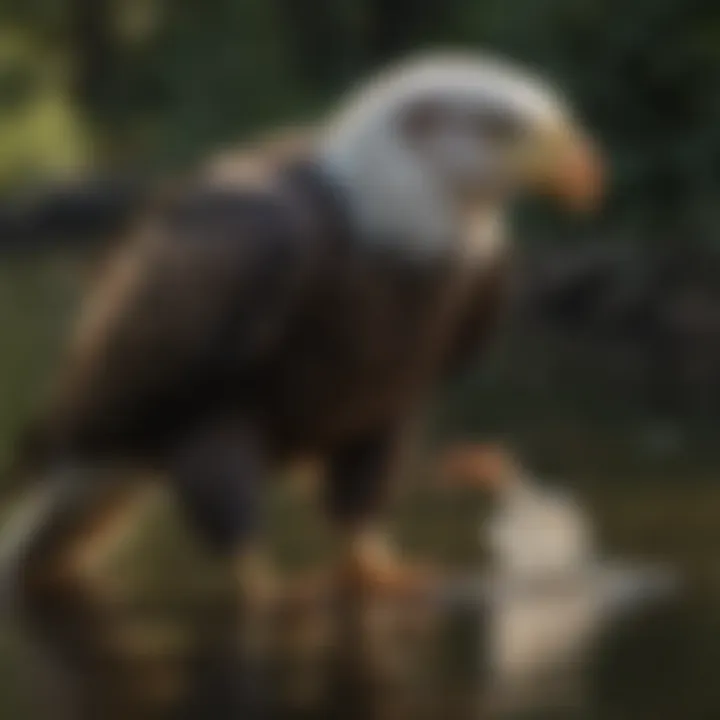Exploring the Bald Eagle: Classification & Ecology


Intro
The bald eagle, scientifically known as Haliaeetus leucocephalus, is more than just a national symbol. Recognized for its distinctive white head and tail, it plays a crucial role in the ecosystems it inhabits. Understanding its scientific classification and ecological significance sheds light on not only its behaviors and habitat but also its importance to biodiversity and conservation efforts.
Understanding Woodland Ecosystems
Importance of Biodiversity in Forests
Woodland ecosystems provide essential services that are often overlooked. The variety of species, including trees, plants, and animals, contributes to resilience against environmental changes. Such biodiversity is vital for processes like pollination and nutrient cycling. In the context of the bald eagle, various woodland inhabitants, such as fish, rodents, and birds, form a crucial part of its food web. Without these species, the bald eagle’s survival would be threatened.
Role of Forests in Climate Regulation
Forests, which provide habitat for many species, including the bald eagle, also play a significant role in climate regulation. They sequester carbon, thus mitigating climate change. As the dense tree canopy absorbs sunlight, it can impact local weather patterns positively. The interdependence of bald eagles and forested regions illustrates how habitat preservation is vital for maintaining ecological balance.
"The preservation of woodlands is not simply an effort for wildlife; it is a dedication to sustaining the planet's ecological health."
Sustainable Forestry Practices
Principles of Sustainable Forestry
Sustainable forestry is essential for ensuring that woodlands can continue to support species like the bald eagle. This approach involves managing forests in a way that meets current needs while ensuring future generations can do the same. Key principles include:
- Minimizing impact on biodiversity: Careful harvesting techniques help maintain species diversity.
- Maintaining ecosystem services: Ensuring that forests continue to provide clean air, water, and habitat.
- Monitoring and adaptive management: Regularly assessing forest health and adapting practices accordingly.
Case Studies of Successful Implementations
Numerous successful implementations of sustainable forestry practices exist globally. For example, forest management in the Pacific Northwest has increased the populations of various wildlife, including bald eagles. By employing selective logging techniques and restoring degraded habitats, these areas have seen a resurgence in biodiversity. Attention is paid to species needs, ensuring that habitats remain intact.
Woodland Stewardship Techniques
Forest Management Plans
Effective forest management plans outline strategies for sustainable use and conservation. These plans incorporate scientific research to guide decisions, considering the needs of wildlife and the impact on ecosystems. For the bald eagle, nesting sites and hunting territories must be protected through well-structured management initiatives.
Conservation Strategies
A multifaceted approach to conservation is crucial. This might include protecting large expanses of forest to maintain habitat connectivity. Engaging local communities in conservation can foster stewardship and increase awareness about physical resources. Specific strategies can involve:
- Establishing wildlife corridors to ensure eagle populations can thrive.
- Implementing educational programs to inform the public about the bald eagle’s role in the ecosystem.
Through understanding and addressing ecological needs, it is possible to enhance both bald eagle populations and overall woodland health.
Prologue to the Bald Eagle
The bald eagle, known for its distinctive white head and tail against a darker body, represents more than just an avian species. This iconic bird holds significant ecological and cultural value in North America. Understanding the bald eagle is crucial, not only because it is the national bird and symbol of the United States but also due to its role in the ecosystem as a top predator. Exploring its classification, habitat, behavior, and conservation allows for a holistic view of this majestic creature.
The bald eagle inhabits a range of environments, predominantly near large bodies of open water, where it can hunt for its main prey, fish. Its presence is indicative of a healthy ecosystem and clean waterways. As a keystone species, the bald eagle helps maintain balance within its habitat by regulating prey populations.
Understanding Scientific Classification
An appreciation for the bald eagle begins with its scientific classification. The classification system provides a structured framework that helps identify and categorize all living organisms. Biological classification, known as taxonomy, organizes species based on shared characteristics. For the bald eagle, the scientific name is Haliaeetus leucocephalus, derived from Latin and Greek roots.
- Genus: Haliaeetus - This name refers to fish eagles, highlighting the bald eagle's primary diet.
- Species: leucocephalus - This term translates to "white-headed" in Greek, which directly describes the bird's most recognizable feature.
This classification is important, as it connects the bald eagle to its relatives, like the white-tailed eagle and the Steller’s sea eagle, which also belong to the same genus. Understanding these relationships contributes to the study of avian biology and ecology.
The classification reflects not only physical traits but also evolutionary relationships, where shared ancestry can reveal insights into behaviors and adaptations. This framework is essential for conservation efforts and understanding population dynamics as it leads to better management strategies.
Scientific Name of the Bald Eagle
The scientific name of the bald eagle is central to our understanding of this majestic bird. Referring to it as Haliaeetus leucocephalus provides a precise identification within the broader context of avian species. This classification is vital not only for researchers but also for conservation practitioners who aim to preserve and manage eagle populations effectively. Knowledge of the scientific name assists in categorizing the bald eagle alongside its close relatives in the family Accipitridae, which also includes other birds of prey like hawks and kites. This classification system lays the groundwork for a deeper comprehension of its ecological needs and behavioral patterns.
Etymology of Haliaeetus leucocephalus
The name Haliaeetus leucocephalus derives from Greek and Latin roots. The genus name Haliaeetus comes from the Greek word "haliaetos," meaning sea eagle, reflecting the bird's habitat often near coasts and large bodies of water. The species name leucocephalus combines the Greek prefix "leuco-" meaning white, and "cephalus," meaning head. This directly alludes to the bald eagle's distinctive white head and tail feathers, which contrast with its dark brown body. Understanding this etymology provides insight into how this species has been viewed historically and how its physical characteristics have influenced its naming.
Classifications within the Animal Kingdom
In terms of classification, the bald eagle resides in the kingdom Animalia, within the phylum Chordata, and class Aves. More specifically, it falls under the order Accipitriformes, which encompasses various birds of prey known for their keen eyesight and hunting skills. The family Accipitridae includes notable predators such as the golden eagle and the hawk. The distinctive fewer characteristics of Haliaeetus leucocephalus set it apart from its relatives. Primarily, this is reflected in its larger size and unique nesting behavior.
The classification of Haliaeetus leucocephalus is crucial for conservation efforts, providing a framework for identifying potential threats and effective management strategies.
Summary
Understanding both the etymology and classification within the animal kingdom highlights the bald eagle's biological significance. These scientific elements allow researchers and conservationists to communicate about the species effectively. Having this shared understanding is essential for the efforts aimed at ensuring the survival of Haliaeetus leucocephalus in its natural habitat.
Morphological Characteristics


Understanding the morphological characteristics of the bald eagle is essential for appreciating its adaptation and role within ecosystems. These traits not only serve functional purposes in its daily life but also influence its interaction with the environment and other species. The physical aspects of the bald eagle contribute to its identity, as well as its capability to thrive in various habitats.
Physical Description
The bald eagle, scientifically known as Haliaeetus leucocephalus, exhibits remarkable physical features that set it apart in the avian world. One of the most recognizable traits is the adult's striking white head and tail, which contrasts sharply with its dark brown body and wings. This coloration plays a significant role in both mating rituals and territorial displays. An adult bald eagle can reach a wingspan of up to 7.5 feet, making it one of the largest birds of prey in North America. Their beaks are large and hooked, perfectly designed for catching and ripping apart prey, an essential adaptation for their diet.
Furthermore, their sharp talons are a critical tool for hunting and perching. These physical attributes not only make the bald eagle a formidable predator but also influence its nesting habits and territorial behavior. Analyzing these characteristics provides insight into how the bald eagle maintains its position as a top predator within its ecosystem.
Sexual Dimorphism
Sexual dimorphism is evident in the bald eagle, albeit subtle. Males are generally smaller than females, which is common in many avian species. Adult female bald eagles can be up to 25% larger than their male counterparts. This size difference offers an advantage during nesting and hunting, allowing females to incubate eggs effectively while males engage in foraging.
The coloration between sexes is similar, which complicates visual identification. However, during mating season, size can help observers differentiate between them. Additionally, females often require more food resources during egg-laying periods. Understanding this aspect of sexual dimorphism is crucial for recognizing the different roles each sex plays in reproduction and parenting.
The implementation of selective pressures can be seen in the characteristics of the bald eagle, highlighting the importance of morphology in survival and reproduction.
In summary, the bald eagle's morphological characteristics are not just details of its appearance; they are vital elements that aid its survival and effectiveness in its ecological niche. From physical traits such as size and coloration to the implications of sexual dimorphism, these factors are key to understanding the species’ behavior and role within its ecosystem.
Habitat and Distribution
Understanding the habitat and distribution of the bald eagle is crucial for several reasons. Firstly, it informs us about the environmental needs of this species, guiding conservation efforts. Secondly, knowing where bald eagles thrive can help in the management of their populations and their ecosystems. Additionally, habitat preservation is a key aspect of ensuring the survival of not just the bald eagle but also the myriad of species that share its environment.
Geographical Range
The bald eagle, Haliaeetus leucocephalus, is native to North America. Its geographical range extends across various regions, from Alaska and Canada to Mexico and the southern United States. Most commonly, these birds are found in areas close to large bodies of water, which provide abundant food sources. The versatility in their distribution reflects their adaptability to different habitats.
In addition to its broad range, the bald eagle has demonstrated migration patterns linked to seasonal changes. In colder regions, such as those in Canada and Alaska, they migrate south during winter months. This seasonal movement is vital for their survival, as it ensures they can access open waters for fishing. Conservationists closely monitor these patterns to understand better the bald eagle’s migratory behavior.
Preferred Habitats
Bald eagles prefer habitats that offer a combination of food sources, nesting areas, and safe perches. They are commonly found near lakes, rivers, and coastal regions. The importance of these habitats cannot be overstated. Freshwater bodies provide adequate fish populations, and coastal areas offer larger marine resources.
- Nesting Sites:
- Feeding Areas:
- Trees with a height of at least 60 feet are ideal for nesting. They prefer mature trees that can support large nests, often located near water.
- Cliffs and ledges are also utilized, especially in areas where suitable trees are scarce.
- They require access to open waters for hunting. Typically, they are seen near rivers with plenty of fish, making water bodies critical for their sustenance.
- Coastal habitats provide diverse food sources, including fish, small mammals, and birds.
In summary, the habitat and distribution of the bald eagle are vital for its survival. As ecological indicators, they reflect the health of their environment, highlighting the need for ongoing conservation efforts to safeguard these magnificent birds.
Diet and Feeding Habits
The diet and feeding habits of the bald eagle, Haliaeetus leucocephalus, play a fundamental role in understanding its ecological significance. This section examines how the eagle’s dietary choices not only reflect its ecological niche but also impact other species within its habitat. The ability of the bald eagle to adapt its feeding strategies to varying environments emphasizes its resilience and importance in the ecosystem.
Primary Diet
Bald eagles primarily feed on fish, which constitute a significant part of their diet. This reliance on fish demonstrates their adaptability to aquatic habitats. Their hunting often takes place near rivers, lakes, and coastal areas. Some common fish species in the bald eagle’s diet include:
- Salmon
- Trout
- Catfish
- Herring
In addition to fish, bald eagles will occasionally consume small mammals, birds, and carrion when fish is scarce. This dietary flexibility allows them to thrive in different ecosystems, adapting to seasonal changes and food availability. It is interesting to note that the bald eagle can consume up to 4 pounds of food in a single feeding, which is essential for their energy levels during periods of high activity.
Hunting Techniques
Bald eagles employ various hunting techniques that highlight their impressive hunting skills. Their hunting strategies are closely linked to their environment and the types of prey available. Here are a few key techniques:
- Aerial Hunting: Bald eagles soar high in the air, scanning for fish near the surface of water bodies. This method allows them to spot movement and judge distances accurately.
- Plunge Diving: Once they identify a target, bald eagles can dive at speeds up to 100 mph to catch fish. They utilize their sharp talons to grasp slippery prey.
- Stealing from Other Birds: In some cases, bald eagles will steal food from other birds, particularly ospreys and gulls. This behavior showcases their adaptability and assertiveness in securing food resources.
"The bald eagle's ability to hunt effectively in varied environments emphasizes its adaptability. These skills are crucial for survival and species propagation."
Through these methods, bald eagles maintain their position as apex predators within their habitats. Understanding their diet and feeding habits offers critical insight into their ecological role, which is central to conserving their populations and habitats.
Behavioral Patterns
Understanding the behavioral patterns of the bald eagle is critical for wildlife conservation and management. This section sheds light on three primary aspects: nesting habits, migration patterns, and territorial behavior. Each of these elements reveals how bald eagles interact with their environment, ensuring their survival and the health of ecosystems.
Nesting Habits
Bald eagles build nests that are often massive structures composed of sticks, grass, and other materials. Typically located high in trees, these nests serve multiple purposes - protection from predators, safety for eggs and chicks, and a vantage point for hunting. The preferred nesting sites are usually within proximity to water bodies, as this facilitates easy access to their primary food source, fish.
Nest construction is a shared effort between male and female eagles, with both contributing to building and maintaining the structure. A well-maintained nest can be reused over several breeding seasons, leading to significant size increases over time, sometimes exceeding 13 feet in width and 8 feet in depth.
According to a study published by the National Audubon Society, successful nesting directly correlates with the availability of nearby fishing grounds.
Migration Patterns
Bald eagles are known for their migratory behavior, although this varies regionally based on climate and food availability. In harsher winter climates, northern populations often migrate southward to find open water and reliable food sources. Adult eagles typically migrate alone, while juveniles may travel in small groups.
Migration can cover hundreds of miles, and eagles rely on thermals and favorable winds to ease their travel. This behavior not only reflects their adaptability but also highlights the importance of maintaining migratory pathways free from development and pollution.


Territorial Behavior
Territoriality is an essential aspect of bald eagle behavior. During the breeding season, eagles establish and defend territories that can range from 1 to 2 square miles. Strong pairs will aggressively defend their area against intruders to safeguard their nest and resources. This behavior is not only vital for individual survival but also helps regulate the population density in an area, thereby preventing over-exploitation of local resources.
These territorial displays can include aerial chasing, vocalizations, and aggressive posturing. Understanding these interactions can provide valuable insights into population dynamics and the ecological balance within their habitats.
Ecological Role
The bald eagle plays a vital role in its ecosystem, serving as both a predator and scavenger. Understanding its ecological significance helps to highlight the interconnectedness of species and habitats. The presence of Haliaeetus leucocephalus signifies a healthy environment, as they are often indicators of ecosystem health. Their hunting and feeding habits can influence prey populations, which in turn can affect overall biodiversity in their habitats.
Role in Ecosystems
Bald eagles are apex predators. This status allows them to maintain the balance in their ecosystems. They primarily hunt fish but will also consume small mammals and carrion when needed. By preying on certain species, bald eagles help regulate these populations, preventing overpopulation and the resultant strain on resources.
Interestingly, their feeding habits also contribute to nutrient cycling. Leftovers from their meals become food sources for other animals, such as scavengers. Thus, bald eagles indirectly support a variety of other species.
"The bald eagle showcases the complex interactions within food webs, serving as a crucial link in maintaining ecological balance."
Eagle pairs will often return to the same nesting site annually. These sites become important breeding grounds and are essential for the health of the eagle population. The nests themselves can become habitats for other species that seek shelter.
Impact on Biodiversity
The impact of bald eagles on biodiversity extends beyond their role as predators. Their presence in a habitat often indicates a thriving ecosystem. When eagle populations decline, it can signal disruptions within the environment that may necessitate further investigation.
Bald eagles occupy a variety of habitats, including coastal regions, wetlands, and forested areas. Their adaptability helps them thrive in diverse environments, which in turn promotes a rich biodiversity in those areas. Other species, both fauna and flora, benefit from the various habitats created by the bald eagle's foraging and nesting activities.
In summary, the ecological role of the bald eagle is multifaceted. It contributes significantly to the maintenance of ecological balance, biodiversity, and the health of its environment. Understanding these roles reinforces the importance of conservation efforts aimed at protecting this majestic bird.
Conservation Status
Understanding the conservation status of the bald eagle is crucial to the broader discourse on wildlife management and ecological preservation. The bald eagle, scientifically known as Haliaeetus leucocephalus, serves as an important indicator of environmental health. Therefore, its conservation status not only reflects the well-being of the species but also highlights the challenges faced by its ecosystems. Assessing the conservation status allows stakeholders to implement targeted efforts that can effectively mitigate threats.
Historical Threats
Historically, the bald eagle faced numerous threats that led to its precarious status. DDT, a pesticide widely used in the mid-20th century, severely impacted eagle populations. This chemical accumulated in the food chain and caused thinning of eggshells, leading to reproductive failures. Environmental pollution continued to be a significant concern, affecting the quality of habitats essential for nesting and feeding.
Additionally, habitat destruction played a crucial role in the decline of bald eagles. Urban expansion, logging, and agriculture led to loss of breeding and foraging areas. Human encroachment not only reduced available territory but also elevated conflict between eagles and human activities. Such pressures pushed the species to the brink, resulting in its classification as endangered in several regions of North America.
Current Conservation Efforts
Today, conservation efforts aimed at safeguarding the bald eagle have made a notable impact. The banning of DDT in the United States in 1972 marked a pivotal moment for the species, as it allowed for recovery in many areas.
Furthermore, various organizations, including the U.S. Fish and Wildlife Service, are engaged in habitat restoration projects that focus on critical eagle nesting sites. These initiatives aim to restore wetlands and maintain the integrity of riparian zones, thus providing a safe environment for eagles to thrive.
Public education campaigns are also essential to the success of conservation efforts. Raising awareness about the significance of bald eagles helps foster community involvement in wildlife protection and encourages the reporting of illegal activities that threaten these birds. Ongoing research, such as monitoring population numbers and migration patterns, is fundamental to adapting conservation strategies.
"The recovery of the bald eagle is a testament to the power of committed conservation efforts."
Cultural Significance
The cultural significance of the bald eagle transcends its role within the ecosystem and highlights its importance in various human contexts. This majestic bird has become a symbol of strength, freedom, and resilience. It is not only featured in art and literature but also represents deeper values and beliefs in societies across North America. The bald eagle’s image is woven into the identities of many Indigenous cultures, forming an integral component of their spiritual and cultural narratives.
Symbolism in Indigenous Cultures
For many Indigenous peoples, the bald eagle holds a revered place among animals. It is often considered a sacred creature that embodies the spirit of the sky and serves as a messenger between humans and the divine. Different tribes, such as the Lakota and the Ojibwe, have rich traditions surrounding the eagle. They regard its feathers as powerful symbols of honor and respect, often using them in ceremonial practices and rituals.
The eagle's keen eyesight and ability to soar high are often seen as metaphors for vision and perspective. Its presence in folklore and stories illustrates important values such as bravery, loyalty, and respect for nature. As noted by various studies, Indigenous cultures have long understood the significance of the bald eagle in maintaining a balance within their spiritual practices.
"The bald eagle signifies connection to the earth and our responsibilities toward it."
Representation in Modern Society
In contemporary culture, the bald eagle continues to symbolize freedom and the values held by American society. It became the national bird and emblem of the United States in 1782, representing the ideals of democracy and the pursuit of happiness. The choice of the bald eagle for this role reflects both its striking appearance and its status as a top predator.
Bald eagles are often featured in a variety of media, including books, films, and advertisements. They are also prominent in environmental campaigns, calling attention to conservation efforts and the health of ecosystems. Organizations dedicated to the preservation of natural habitats frequently use images of eagles to symbolize wildlife resilience and the importance of protecting threatened species.
As the bald eagle continues to capture public interest, it plays a vital role in educational programs aimed at promoting wildlife conservation. It serves as a bridge between understanding ecological dynamics and fostering respect for nature in future generations. Overall, the cultural significance of the bald eagle reflects a blend of historical, spiritual, and social elements that contribute to its enduring legacy.
Research and Studies
Research and studies play a crucial role in understanding the bald eagle. They help uncover essential details about its behavior, habitat, and interactions within ecosystems. By studying the bald eagle, scientists gain insights into broader ecological trends and the effectiveness of conservation strategies. The findings can inform wildlife management policies and initiatives aimed at preserving this majestic species.
A focused approach to research enables the identification of specific challenges faced by bald eagles. Ongoing studies also assess environmental changes that impact their habitats. This highlights the need for adaptive management practices to ensure the species thrives in changing conditions.
Key Research Initiatives
Several key research initiatives have significantly advanced our understanding of the bald eagle. Among them, the North American Bald Eagle Recovery Plan stands out. This plan aims to safeguard bald eagles through habitat preservation and protection from environmental threats.


Additionally, numerous studies focus on tracking migratory patterns, which provide essential data on their seasonal movements and the ecological factors influencing these behaviors.
Some notable initiatives include:
- Monitoring Breeding Success: Researchers track nesting sites and breeding success to evaluate population health.
- Radio Telemetry: This technique helps understand bird movement patterns across various habitats.
- Environmental Impact Studies: These assess the effects of pollutants on eagle health and reproduction.
Findings on Population Dynamics
Studies of bald eagle population dynamics reveal encouraging trends. Following conservation efforts, many populations have rebounded from previous declines. The delisting of the bald eagle from the Endangered Species Act in the United States exemplifies this success. Current research indicates that populations are now stabilizing or increasing in certain regions.
Key findings include:
- Reproductive Rates: In many areas, bald eagles have shown improved reproductive success, which correlates with habitat restoration efforts.
- Habitat Use: Research indicates flexibility in habitat use, as some eagles adapt to urban environments, which was not common in the past.
- Population Estimates: Recent surveys have provided updated population estimates, essential for future conservation planning.
"Long-term studies underline that continuous monitoring and habitat protection are essential for sustaining bald eagle populations."
Understanding these dynamics is vital for predicting future trends and ensuring that conservation efforts remain effective.
Challenges and Threats
Understanding the challenges and threats facing the bald eagle is crucial. These elements not only influence the species' survival but also provide insights into broader environmental health. Preservation of the bald eagle directly correlates with specific conservation efforts and ecosystem stability. Recognizing these threats helps in formulating effective strategies for long-term management and protection.
Environmental Challenges
Environmental challenges present a significant barrier to the bald eagle's survival. Habitat loss remains one of the most pressing issues. As urban areas expand and land is developed, the natural habitats that eagles rely on diminish, impeding their nesting and hunting sites. Pollution, especially from pesticides and heavy metals, poses additional risks. These contaminants can accumulate in the food chain, harming eagles through bioaccumulation. Moreover, climate change intensifies these problems. Altered weather patterns can affect fish populations, the primary diet of the bald eagle. Changes in water temperatures and quality can lead to reduced fish availability, making it harder for eagles to find food.
Unplanned human activities disrupt nesting, leading to increased mortality rates of young eagles. Furthermore, wind turbines and power lines present additional danger by increasing mortality from collisions.
Human-Wildlife Conflicts
Human-wildlife conflicts are another dimension of threats to bald eagles. As people encroach on natural habitats, the likelihood of encounters increases. Farmers often consider eagles a threat to their poultry or livestock. This perception can lead to intentional harm or lethal control measures against eagles.
Additionally, increased recreational activities near nesting sites, such as boating or hiking, can disturb eagles, leading them to abandon their nests. Protection of breeding sites is essential but often overlooked in favor of recreational benefits. The local community's knowledge is vital in creating a balance that allows humans and eagles to coexist.
Thus, addressing these conflicts requires education and community engagement. Understanding the ecological role of the bald eagle can foster a culture of respect and promote coexistence rather than conflict.
Future of the Bald Eagle
The future of the bald eagle is a crucial topic for understanding both the species itself and the broader ecological systems it inhabits. This majestic bird is often seen as a symbol of wildlife conservationsuccess, and it serves as an important indicator of environmental health. As we look ahead, it's vital to examine the factors that will shape the bald eagle's future and the implications these factors may have for ecosystems and conservation efforts.
Predictions for Population Recovery
Given the historical context, predictions for the bald eagle’s population recovery are largely positive. The recovery initiatives undertaken over recent decades have demonstrated significant success. The removal of DDT and other harmful pesticides, coupled with habitat protection efforts, have been instrumental.
Recent estimates indicate that the bald eagle population in the contiguous United States has rebounded to levels not seen in decades. According to the U.S. Fish and Wildlife Service, the populations soared from around 500 pairs in the 1960s to over 300,000 individuals in the 21st century. Protecting nesting sites and designated feeding areas are essential ongoing measures to ensure these birds maintain a sustainable population.
However, several challenges remain. Environmental changes, such as climate fluctuation, can disrupt the habitats and food sources that bald eagles rely on. Despite the successful recovery, it is essential to continue monitoring population trends and adapt management strategies as necessary. The bald eagle serves as both a success story and a reminder of the fragility of wildlife.
Ongoing Research Needs
For the bald eagle to thrive in the future, ongoing research is crucial. Scientists are calling for detailed studies on various aspects of bald eagle biology and ecology.
- Habitat Use: Understanding how eagles adapt to changing environments can provide insights into habitat management.
- Food Sources: Researching the availability of prey species over time. This helps in assessing the impacts of the changing ecosystem on bald eagle populations.
- Genetic Diversity: Maintaining healthy genetic diversity is important for the adaptability and resilience of bald eagle populations. Studies focusing on lineage and genetic health are necessary.
- Impact of Climate Change: Analyzing the effects of climate change on migration, breeding patterns, and population dynamics is paramount.
By focusing on these areas, researchers can help guide effective conservation strategies. Collaborative efforts among wildlife professionals, government agencies, and academic institutions are crucial to ensure that we have the knowledge needed to protect this iconic species moving forward.
The bald eagle is more than a national symbol; it reflects the state of our ecosystems and the ongoing commitment to conservation and biodiversity.
Finale
The conclusion of this article encapsulates the multifaceted importance of the bald eagle, Haliaeetus leucocephalus, within scientific and ecological contexts. This bird is not just a species of avian interest; it is a symbol of resilience and ecological health. Understanding its scientific classification is crucial for appreciating its role in nature and the conservation efforts surrounding it.
Bald eagles serve as an indicator species. Their population trends can signal changes in environmental quality. Thus, studying them helps scientists gauge the health of various ecosystems. Moreover, conservation of the bald eagle is vital, as it links various ecological aspects—habitat preservation, biodiversity, and human-wildlife interactions.
Implications for Conservation
The implications for conservation surrounding the bald eagle extend beyond its survival. Successful conservation efforts for this species have broader effects, ensuring the health of various interconnected ecosystems. Conservation initiatives aimed at protecting the bald eagle can also provide benefits such as:
- Habitat Protection: Safeguarding environments where bald eagles thrive contributes to the overall biodiversity of those areas.
- Legislation and Public Awareness: Efforts to conserve this iconic bird raise public awareness about environmental issues and encourage support for legislative measures.
- Ecosystem Restoration: Focusing on the bald eagle can lead to the restoration of compromised habitats, benefiting other species that rely on these ecosystems.
As the bald eagle continues to recover from previous threats, it serves as a reminder of the importance of ongoing research and adaptive management strategies. By prioritizing the conservation of the bald eagle, we can support healthy ecosystems, promoting sustainable coexistence between wildlife and human interests.
Key Scientific Papers
- Fischer, D. L., & Grace, A. R. (2018). Bald Eagles: Population Recovery in the Midwestern United States. This paper discusses the resurgence of bald eagles across the Midwest due to robust conservation efforts.
- Brown, R. M. (2020). Dietary Habits of Haliaeetus leucocephalus in Urban Environments. The study highlights the adaptability of bald eagles to urban settings and their resource utilization.
- Snyder, N. F. R., & Wiley, J. W. (2021). Nesting Behavior and Success Rates of Bald Eagles in North America. This research provides insights into the nesting success of bald eagles, detailing factors that influence reproductive outcomes.
These papers support the article by providing foundational knowledge and contemporary findings.
Recommended Reading
For those interested in further exploration of the bald eagle’s world, the following resources are recommended:
- “The Bald Eagle: Haunting the Sky” by Jack Johnson. This book covers extensive research on the behavior and ecology of the species, making it an excellent addition to the reading list.
- “Eagles of North America” by John B. Tatum. A broader view of the eagle family, including the bald eagle, with visuals and ecological contexts.
- Website: en.wikipedia.org/wiki/Bald_eagle. An accessible online resource summarizing crucial information and links to further readings.
These recommendations can deepen understanding and appreciation of the bald eagle in various contexts.







